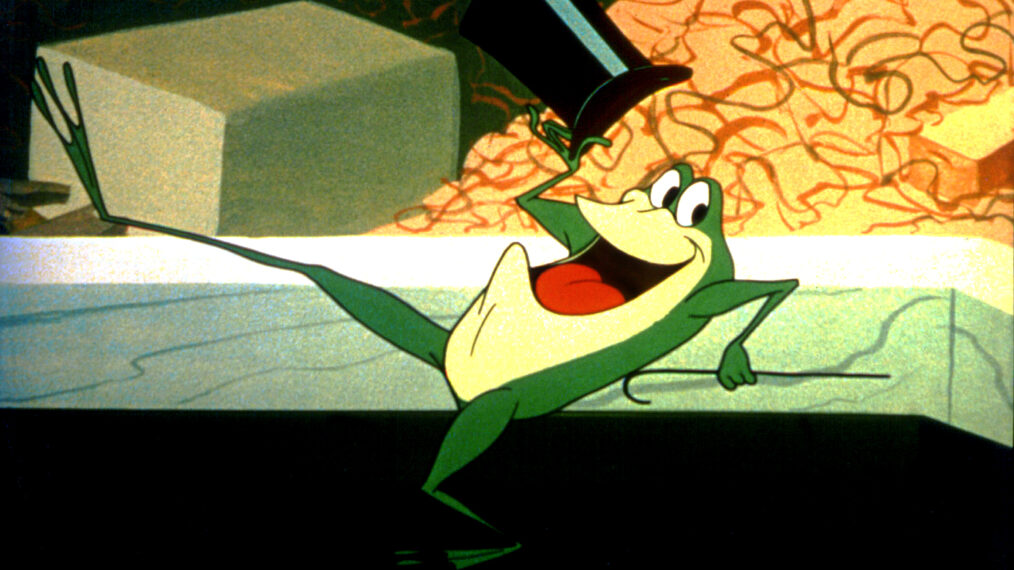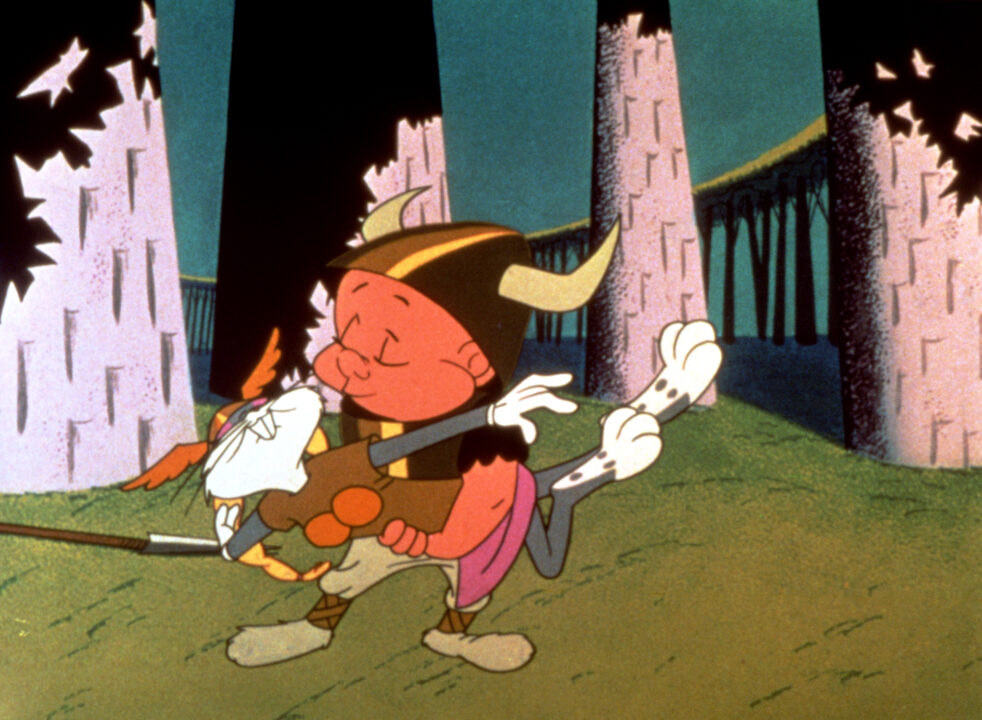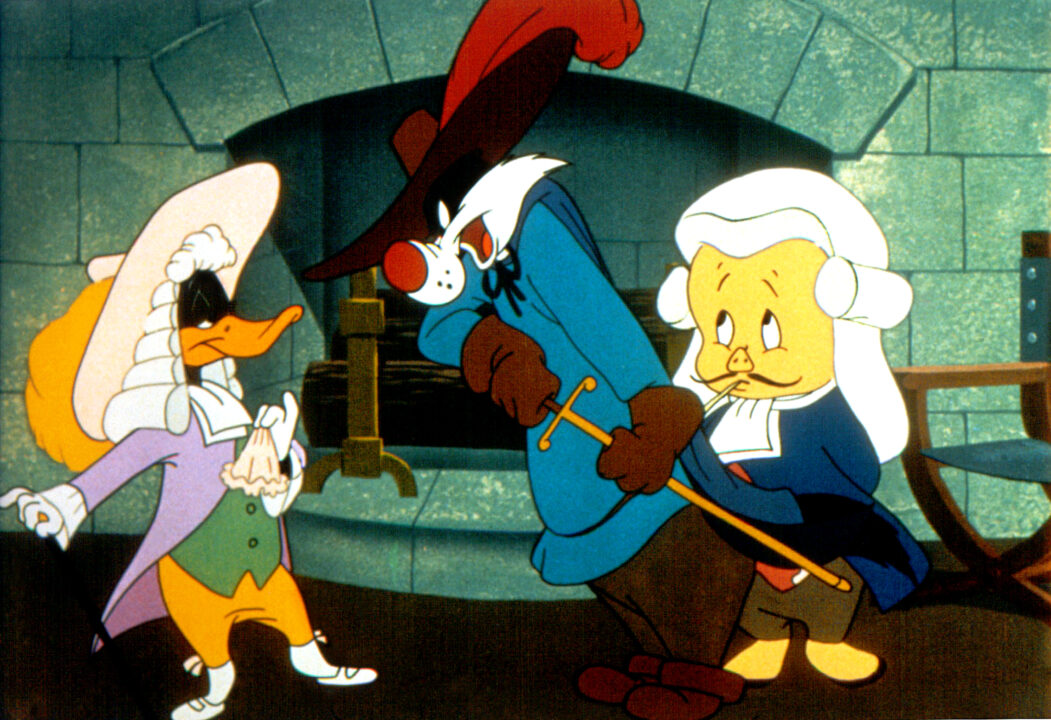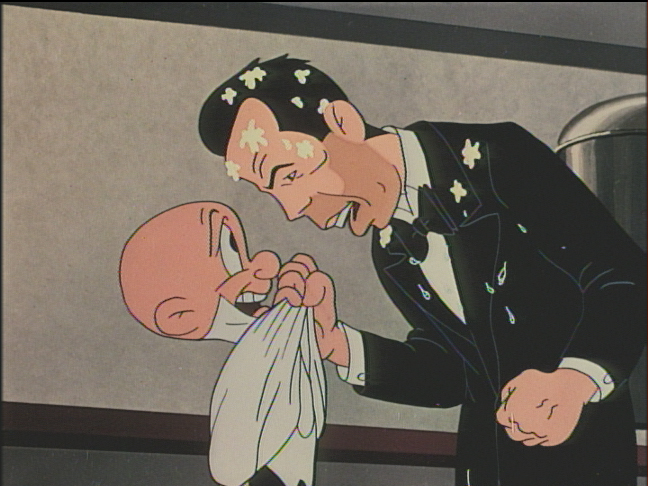Here Are All the ‘Looney Tunes’ & ‘Merrie Melodies’ Cartoons Airing During TCM’s Warner Bros. Centennial Celebration

On April 4, 1923, Warner Bros. was founded. To celebrate the centennial of this iconic studio, Turner Classic Movies (TCM) is devoting its entire April 2023 schedule to nothing but Warner titles.
Much of what is airing will naturally be a number of the great live-action feature films produced by the studio from its beginnings in the silent era, to Hollywood’s mid-century golden age, through the New Hollywood and into modern times.
But, of course, no look at Warner Bros.’ history would be complete without pointing out the classic cartoons the studio produced via its Merrie Melodies and Looney Tunes film series. Those will be featured all month long on TCM as well, with at least one cartoon, usually two or three, airing each day in April.
The Looney Tunes and Merrie Melodies shorts spotlighted on TCM come from legendary animators like Chuck Jones, Fred “Tex” Avery, Isadore “Friz” Freleng, Robert McKimson and Michael Maltese, are often accompanied by wonderfully manic musical scores from Carl Stalling and feature the inimitable Mel Blanc providing many of the vocal characterizations.
A number of the featured titles appear on most short lists of greatest cartoons ever, and a couple have even been selected for preservation in the National Film Registry due to their artistic, historical and cultural importance. (And beside all that, they are still utterly hilarious.)
You’ll see a lot of Bugs Bunny, Daffy Duck, Elmer Fudd, Yosemite Sam and the like, as well as cartoons featuring the first appearances of beloved characters such as Foghorn Leghorn and Cecil Turtle, and more.
Just as you used to be able to see a cartoon before a movie back in the day, so, here, TCM is scheduling these shorts before a movie title that often shares a theme with it (so you’ll see a Bugs Bunny Western parody before an actual Western, for one example).
We’ve got the list of Merrie Melodies and Looney Tunes titles TCM is airing each day in April below. But before you dive in, please read this programming notice for a little clarification on the scheduling:
Scheduling/DVR Notice
The Merrie Melodies and Looney Tunes shorts airing on TCM in April are interstitial programming and will probably not appear in your DVR or onscreen guide. TCM’s schedule gave approximate ending times for the cartoons, as they will be airing just ahead of the movies with which they are associated.
We’ve followed TCM’s example in our listings, giving the approximate end times for the cartoons. To give you some sense of when the cartoons will begin, considering that these shorts usually run seven or eight minutes, you might want to start tuning in at least 10 minutes before the listed end time to ensure you don’t miss any of the looniness!

Bugs Bunny and Elmer Fudd in 1957’s What’s Opera, Doc?, which will air April 7 on Turner Classic Movies (Warner Bros. Entertainment Inc./Courtesy of TCM)
Merrie Melodies & Looney Tunes Airing During TCM’s Warner Bros. Centennial Celebration April 2023 (All Times ET)
Saturday, April 1
Hollywood Steps Out (1941) — ends approximately 8pm, just ahead of the documentary The Brothers Warner.
Tex Avery directed this Merrie Melodies short set at a Hollywood nightclub and featuring caricatures of dozens of legendary stars from the era, including Cary Grant, Claudette Colbert, Norma Shearer, Humphrey Bogart and many more.
Sunday, April 2
Racketeer Rabbit (1946) — ends approximately 6pm, just ahead of film Larceny, Inc. (1942)
On a day that TCM is devoting to some of Warner Bros.’ classic gangster films, it’s fitting that they will also be airing a couple of cartoons with the same theme. In the Looney Tunes short Racketeer Rabbit, directed by Friz Freleng, Bugs Bunny gives the business to two bank robbers modeled after Edward G. Robinson and Peter Lorre, and who were forerunners of Freleng’s Rocky and Mugsy characters.
Bugsy and Mugsy (1957) — ends approximately 8pm, just ahead of film The Public Enemy (1931)
Freleng also helmed this Looney Tunes short featuring the now-established Rocky and Mugsy gangster characters, who tangle with Bugs Bunny.
The Scarlet Pumpernickel (1950) — ends approximately 9:45pm, just ahead of documentary Jack L. Warner: The Last Mogul(1993)
Chuck Jones directed this Looney Tunes entry that often ends up on lists of the greatest cartoons ever. With its title a play on The Scarlet Pimpernel, the story-within-a-story finds Daffy Duck pitching a dramatic role for himself to Warner Bros. chief Jack L. Warner. Daffy’s story is a swashbuckler set in “Merry Old England,” and also features the likes of Sylvester the Cat, Porky Pig and Melissa Duck in her first appearance.

Daffy Duck, Sylvester the Cat and Porky Pig in the 1950 Looney Tunes short The Scarlet Pumpernickel (© Warner Bros./Courtesy Everett Collection)
Monday, April 3
Rhapsody Rabbit (1947) — ends approximately 3:15pm, just ahead of film Rhapsody in Blue (1945)
This Freleng-helmed Merrie Melodies short finds concert pianist Bugs Bunny attempting to overcome various hilarious gags and interruptions as he performs Liszt’s “Hungarian Rhapsody No. 2.”
Big House Bunny (1950) — ends approximately 8pm, just ahead of film Safe in Hell (1931)
Another Freleng Looney Tunes short, this one finds Bugs Bunny getting lost while tunneling and accidentally ending up in “Sing Song Prison,” where prison guard Yosemite Sam tries to keep him from getting out.
Page Miss Glory (1936) — ends approximately 11pm, just ahead of film Page Miss Glory (1935)
Merrie Melodies short directed by Avery.
Tuesday, April 4
Stage Door Cartoon (1944) — ends approximately 8pm, just ahead of film 42nd Street (1933)
Merrie Melodies short directed by Freleng, starring Bugs Bunny and Elmer Fudd, who take their feud onto a vaudeville stage.
Wednesday, April 5
Porky’s Baseball Broadcast (1940) — ends approximately 11am, just ahead of film Elmer, the Great (1933)
Porky Pig leads this Freleng-directed Looney Tunes entry.
Buccaneer Bunny (1948) — ends approximately 8pm, just ahead of film The Sea Wolf (1941)
Bugs Bunny messes with pirate Yosemite Sam in this Looney Tunes short directed by Freleng.
Thursday, April 6
Baseball Bugs (1946) — ends approximately 2:15pm, just ahead of film The Winning Team (1952)
This hilarious Looney Tunes entry directed by Freleng finds Bugs Bunny single-handedly taking on the thuggish players of the Gas-House Gorillas baseball team. The gags are funny, and many of the references to the sport are still timely; the famous “conga line” scene continues to live on in online memes posted by frustrated fans when their team’s pitcher is giving up too many bases.
Rabbit Hood (1949) — ends approximately 8pm, just ahead of film The Adventures of Robin Hood (1938)
This Jones-directed Merrie Melodies title parodies Robin Hood, with Bugs Bunny facing off with the Sheriff of Nottingham. There is even a cameo from Errol Flynn courtesy of live-action footage from Warner Bros.’ The Adventures of Robin Hood, which follows the cartoon.
Friday, April 7
What’s Opera, Doc? (1957) — ends approximately 8pm, just ahead of film They Won’t Forget (1937)
Another Jones-directed classic, this Merrie Melodies title might have been where a lot of people got their first exposure to opera; specifically, the music from Richard Wagner’s operas. Elmer Fudd famously sings “Kill the Wabbit!” to the melody of “The Ride of the Valkyries” as he pursues Bugs Bunny across a brilliantly designed operatic landscape. Often ranked among the greatest cartoons ever, it was the first animated short to be selected for preservation by the National Film Registry for its artistic and cultural significance; the two other Jones shorts selected for the Registry will also air later this month.
Saturday, April 8
A Mutt in a Rut (1959) — ends approximately 10am, just ahead of film Good-Bye, My Lady (1956)
Looney Tunes short directed by Robert McKimson, featuring Elmer Fudd and his dog Rover.
Carrotblanca (1995) — ends approximately 8pm, just ahead of film Casablanca (1942)
The most recently produced Looney Tunes title airing this month, Carrotblanca was produced by the Animaniacs writing team and, as its title suggests, is a parody of the classic Warner Bros. drama Casablanca, which follows. A number of favorite characters take on roles from the film, including Bugs Bunny as Rick, Penelope Pussycat as Ilsa, Daffy Duck as Sam, Sylvester as Victor Lazlo, Pepé Le Pew as Captain Renault, Yosemite Sam as Major Strasser and Tweety as Ugarte.
Sunday, April 9
Easter Yeggs (1947) — ends approximately 11:30am, just ahead of film One Foot in Heaven (1941)
A Looney Tunes short directed by McKimson that is fitting to show on Easter Sunday. It stars Bugs Bunny, Elmer Fudd and the Easter Bunny, who gets Bugs to deliver eggs for him.
A Star Is Bored (1956) — ends approximately 8pm, just ahead of film A Star Is Born (1954)
Freleng directed this Looney Tunes title that expands the rivalry between Bugs and Daffy.
Monday, April 10
Hair-Raising Hare (1946) — ends approximately 4:30pm, just ahead of film Dracula Has Risen From the Grave (1969)
Merrie Melodies short directed by Jones that introduces the big orange monster, Gossamer.
14 Carrot Rabbit (1952) — ends approximately 8pm, just ahead of film The Treasure of the Sierra Madre (1948)
Bugs Bunny and Yosemite Sam go at it again in this Looney Tunes short directed by Freleng.
Tuesday, April 11
Tweety’s S.O.S. (1951) — ends approximately 8pm, just ahead of film Now, Voyager (1942)
Merrie Melodies short directed by Freleng finds Sylvester the Cat stowing away aboard the cruise ship on which Tweety Bird and Granny are passengers.
Wednesday, April 12
Bugs and Thugs (1954) — ends approximately 8pm, just ahead of film White Heat (1949)
Bugs Bunny tangles once again with bank robbers Rocky and Mugsy in this Looney Tunes short directed by Freleng.
Yankee Doodle Daffy (1943) — ends approximately 10:30pm, just ahead of film Yankee Doodle Dandy (1942)
This Looney Tunes short directed by Freleng was the second one to pair Daffy Duck and Porky Pig, and is one of the few classic Warner Bros. cartoons to now be in the public domain.
Thursday, April 13
There Auto Be a Law (1953) — ends approximately 11:30am, just ahead of film Greased Lightning (1977)
McKimson-directed Looney Tunes short poking fun at various aspects of automobiles.
Go Fly a Kit (1957) — ends approximately 5:30pm, just ahead of film The Spirit of St. Louis (1957)
Looney Tunes short directed by Jones.
Drip-Along Daffy (1951) — ends approximately 8pm, just ahead of film The Searchers (1956)
A Merrie Melodies parody of Westerns led by Daffy Duck and Porky Pig, directed by Jones.
Friday, April 14
Ballot Box Bunny (1951) — ends approximately 5:30pm, just ahead of film A Face in the Crowd (1957)
Freleng helmed this Merrie Melodies short that finds Bugs Bunny and Yosemite Sam running against each other for mayor of a small town.
Sahara Hare (1955) — ends approximately 8pm, just ahead of film The Land of the Pharaohs (1955, a newly remastered version)
Bugs and Yosemite Sam go at it again in this Freleng-directed Looney Tunes title, this time in the Sahara Desert, where Bugs accidentally winds up after once again “not making that left turn at Albuquerque.”
Saturday, April 15
Ant-Pasted (1953) — ends approximately 9am, just ahead of film Them! (1954)
Looney Tunes title directed by Freleng and starring Elmer Fudd.
The Haunted Mouse (1941) — ends approximately 11am, just ahead of film The Bad Seed (1956)
Looney Tunes short directed by Avery and the first cartoon written by frequent Warner Bros. storyman Michael Maltese.
Lumber Jerks (1955) — ends approximately 8pm, just ahead of film My Fair Lady (1964)
The Goofy Gophers lead this Looney Tunes short from Freleng.
Sunday, April 16
Rabbit Fire (1951) — ends approximately 8pm, just ahead of film Who’s Afraid of Virginia Woolf? (1966)
Jones’ Looney Tunes classic starring Bugs Bunny, Daffy Duck and Elmer Fudd, which introduced the famous “Duck Season vs. Rabbit Season” argument and the first in the “hunting trilogy.”
Monday, April 17
Swooner Crooner (1944) — ends approximately 12:30pm, just ahead of film Ocean’s 11 (1960)
Oscar-nominated Looney Tunes short directed by Frank Tashlin, starring Porky Pig.
Bugs Bunny Rides Again (1948) — ends approximately 12:30pm, just ahead of film Rio Bravo (1959, new remastered version)
Freleng directed this Merrie Melodies Western parody starring Bugs Bunny and Yosemite Sam.
Zipping Along (1953) — ends approximately 1am, just ahead of film Strangers on a Train (1951)
This Merrie Melodies title is another hilarious Jones-directed short featuring Wile E. Coyote — once again demonstrating his inexplicable brand loyalty to Acme products — and the Road Runner engaged in their eternal pursuit. In the video below chronicling the Coyote’s Top 10 most epic fails, four of them come from Zipping Along.
Tuesday, April 18
The Last Hungry Cat (1961) — ends approximately 6pm, just ahead of film Stage Fright (1950)
Tweety and Sylvester clash again in this Merrie Melodies entry codirected by Freleng and Hawley Pratt.
Duck Amuck (1953) — ends approximately 8pm, just ahead of film Mildred Pierce (1945)
This Daffy Duck-led Merrie Melodies short is one of the three Chuck Jones-directed cartoons selected for preservation in the National Film Registry, which describes the film as “one of the defining examples of Chuck Jones’ irreverent creativity. … Duck Amuck does more than pierce film’s fourth wall, it demolishes it, sending Daffy on a series of surreal misadventures.”
Wednesday, April 19
Slick Hare (1947) — ends approximately 6pm, just ahead of film Black Legion (1937)
Freleng directed this hilarious Merrie Melodies entry that features Bugs Bunny and Elmer Fudd at odds again, this time at an upscale Hollywood restaurant where Elmer is the cook. When Humphrey Bogart (one of many caricatures of big Warner Bros. stars of the era featured in the cartoon) demands Elmer make him fried rabbit for Lauren Bacall (also featured in a caricature), the chase is on, and even includes Bugs dancing to a Carmen Miranda number.

“Why did you hit me in the face with a coconut custard pie with whipped cream?” Bogie asks Elmer Fudd in Slick Hare (Warner Bros. Entertainment Inc./Courtesy TCM)
Thursday, April 20
Rabbit Seasoning (1952) — ends approximately 8pm, just ahead of film Alice Doesn’t Live Here Anymore (1974)
This Merrie Melodies title is a sequel to Rabbit Fire and the second in Jones’ “hunting trilogy” featuring Bugs, Daffy and Elmer Fudd. It’s another Jones title that is often featured on short list of greatest cartoons.
Friday, April 21
Hillbilly Hare (1950) — ends approximately 1pm, just ahead of film Ode to Billy Joe (1976)
McKimson helmed this Merrie Melodies Bugs Bunny short that culminates in an epically looney square dance, with Bugs calling out wild dance instructions that the titular hillbillies follow to the letter.
Baby Buggy Bunny (1954) — ends approximately 8pm, just ahead of film Bonnie and Clyde (1967)
Bugs clashes with a gangster named “Babyface” Finster, who is disguised as an orphan baby in an effort to reclaim the stolen loot he stashed in the rabbit’s hole, in this Jones-directed Merrie Melodies cartoon.
Saturday, April 22
Captain Hareblower (1954) — ends approximately 10am, just ahead of film Captain Horatio Hornblower (1951)
Merrie Melodies title directed by Freleng with Bugs up against Yosemite Sam as a pirate.
What’s Up, Doc? (1950) — ends approximately 8pm, just ahead of film All the President’s Men (1976)
Released to celebrate what was then Bugs Bunny’s 10th birthday, this Looney Tunes short directed by McKimson finds the wascally wabbit recounting his life story to a reporter.
Sunday, April 23
Scent-imental Romeo (1951) — ends approximately 1:30pm, just ahead of film Fanny (1961)
A Jones-directed Merrie Melodies short starring Pepé Le Pew and Penelope Pussycat.
Duck Dodgers in the 24 1/2th Century (1953) — ends approximately 8pm, just ahead of film Superman (1978)
Another Jones masterpiece, this Merrie Melodies parody of space operas features Daffy Duck in his first appearance as space ace “Duck Dodgers,” along with Porky Pig and Marvin the Martian.
Monday, April 24
One Froggy Evening (1955) — ends approximately 8pm, just ahead of film The Color Purple (1985)
The third Chuck Jones-directed Merrie Melodies title selected for preservation by the National Film Registry, which describes the hilarious short this way: “A cartoon on every short list of the greatest animation, this classic Chuck Jones creation features crooning amphibian Michigan J. Frog, who drives his owner insane by singing only in private, but never in public.”
Tuesday, April 25
Don’t Look Now (1936) — ends approximately 8pm, just ahead of film Romance on the High Seas (1948)
Tex Avery directed this Merrie Melodies entry about Cupid making people fall in love, while Satan tries to undermine the romances.
Wednesday, April 26
Walky Talky Hawky (1946) — ends approximately 8pm, just ahead of film East of Eden (1955)
Robert McKimson directed this Merrie Melodies entry featuring Henery Hawk, and Foghorn Leghorn and Barnyard Dawg in their first appearances.
Thursday, April 27
Feed the Kitty (1952) — ends approximately 3:30pm, just ahead of film Spencer’s Mountain (1963)
Bulldog Marc Anthony and kitten Pussyfoot make their first appearances in this Merrie Melodies short directed by Jones.
The Three Little Bops (1957) — ends approximately 8pm, just ahead of film Bird (1988)
This Looney Tunes title directed by Freleng offers a hip, jazzy musical take on the story of the Three Little Pigs.
Friday, April 28
Long-Haired Hare (1949) — ends approximately 8pm, just ahead of film Woodstock: The Director’s Cut (1970)
In this Jones-directed Looney Tunes title, Bugs Bunny gets payback on snobby and pompous opera singer Giovanni Jones by disrupting his performance with a series of pranks.
Saturday, April 29
My Bunny Lies Over the Sea (1948) — ends approximately 8pm, just ahead of film Local Hero (1983)
After once again “not making that left turn at Albuquerque,” Bugs Bunny winds up in Scotland, where he clashes with a Highlander, in this Merrie Melodies short directed by Jones.
Sunday, April 30
Tortoise Beats Hare (1941) — ends approximately 11:30am, just ahead of film Chariots of Fire (1981)
Cecil Turtle makes his first appearance in this Avery-directed Merrie Melodies cartoon based on Aesop’s fable, and one of the rare films in which Bugs Bunny takes a few L’s.
Rabbit of Seville (1950) — ends approximately 8pm, just ahead of film Malcolm X (1992)
The final cartoon during this monthlong celebration of all things Warner Bros. on TCM is this Chuck Jones-directed Looney Tunes short starring Bugs Bunny and Elmer Fudd, with its humor paced musically around the overture to the Rossini opera The Barber of Seville.

